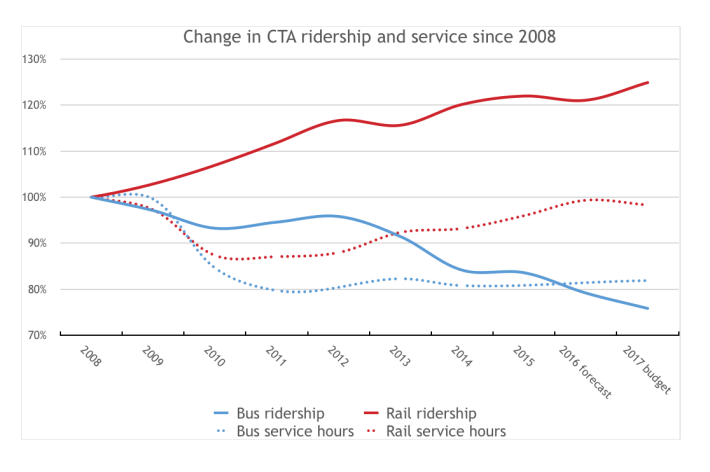
Earlier this week the Chicago Transit Authority announced its proposed budget for 2017. Mayor Rahm Emanuel touted the fact that the budget "freezes" the $2.00 and $2.25 cash fare on buses and trains, respectively.
The CTA holding the line on fares – for the eighth consecutive year – creates positive publicity for Emanuel, even while he raises many other fees in Chicago. Agency spokesman Jeffrey Tolman said "we will continue to look for ways to keep CTA as affordable as possible while maintaining the high level of service."
However, it would be wiser for the CTA to raise fares incrementally each year to accommodate perennially rising costs, and give itself more breathing room to add or expand bus route changes without having to find an equivalent cost to cut elsewhere in the budget.
The agency's repeated decisions not to change the "base" fare could lead to a future doomsday scenario. Chicago is currently experiencing a building boom, but if development slows the CTA will have less funding from its share of local sales taxes, and from the real estate transfer tax (a tax on property sold). At that point it will need to cut staff and service, or raise fares steeply, to a price that would likely be higher than if the fares were raised periodically.
Even the language in the CTA's budget document bemoans the scarcity of transit funding, stating, "CTA continues to face funding challenges to meet our ambitious modernization goals."
Although the total number of rail and bus rides in 2015 was 516 million, up 1.6 percent from 514.5 million in 2014, the current budget projects that total annual ridership will have dropped by nearly 17 million rides from 2015 to 2016. A majority of this drop will be seen on bus routes. The CTA also predicts a total drop of 3.4 million rides, all of them on bus routes, between 2016 and 2017. The agency is projecting an increase in rail ridership.
Tolman said the drop in bus ridership is caused by "low gas prices, traffic congestion, [and] shifting population trends." He added, "CTA ridership, especially bus, has been heavily influenced by gas prices over the last 20 years. Inflation adjusted gas prices are near 100-year lows and are forecasted to remain low in 2017." Figures from the Federal Highway Administration show that people drove more last year than the previous peak in 2014, which followed a decline during the recession.
The budget also attributes the ridership drop to the Divvy bike-share system, competition from ride-hailing services, and slower bus speeds. The document also states that improved walkability in some parts of Chicago has been a factor in fewer people riding CTA buses and trains. Tolman explained, "CDOT has made a number of improvements to increase walkability across the entire city including improvements to sidewalks, intersections, [and] streetscapes."
The large majority of the CTA's recent infrastructure investments have involved upgrading or replacing rail stations. Some studies suggest that people find service frequency and travel time to be the most important determinants of rider satisfaction. Fare prices were found to be a moderately important factor, and Wi-Fi was found to be relatively unimportant.
The federal government provides the bulk of CTA's capital funding, but most of that money has been used to build and replace stations and rail routes, as well as to create the Loop Link express bus corridor. Sometimes money is available for overhauling vehicles, but nothing is available for maintaining stations.
The CTA is doing what it can to stop the ridership losses by increasing service in some areas, but current plans don't call for new bus rapid transit service. The proposed Ashland BRT plan was backburnered after fierce opposition from some residents and business owners to plans to convert travel lanes to bus-only lanes and prohibit most left turns from Ashland.
Tolman hinted the CTA may implement the Ashland plan in the future. "We are considering options and potential modifications, including the inclusion of additional left turns, based on that public feedback," he explained. "We also are continuing the process of securing funding to continue project design. Currently, there is no specific timetable or sources set for the design funding so it does not make sense to include it in the 2017 capital plan." The Ashland BRT project isn't in the CTA's 2017-2021 Capital Improvement Plan either.
The CTA recently extended bus routes and added service in the Far South Side and Southeast Side, and is testing off-board bus fare collection on the Dearborn/Madison Loop Link platform and the Belmont Blue Line station to speed up boarding. The practice should be expanded to all Loop Link stations, but there isn't yet a plan to do so. Tolman said the results from there, and the Belmont stop, where prepaid boarding will be made permanent as part of an upcoming station rehab will inform decisions about where else in the city they should implement it.
In partnership with the Chicago Department of Transportation, CTA has added Transit Signal Priority on Ashland Ave. between 95th St. and Cermak Rd., and will expand this all the Irving Park Road next year. The TSP computer will notice when buses are approaching intersections and can decide to hold a green light on Ashland longer, or change to green sooner.
Not only are low gas prices causing people to drive more, total gas sales have an effect on CTA's finances. Illinois gas tax has been stuck at 19 cents a gallon since 1991. Due to inflation, that money – divvied amongst many transportation agencies in the state – has less and less buying power each year. So even as more people are driving more than ever, the CTA receives less revenue each year, in terms of what that money will buy.




